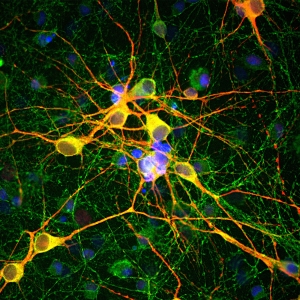Already this year, our Chicken Tuj-1 (Neuron-specific Class III beta-Tubulin) antibody (Cat.# CH23005) has been used in two publications, demonstrating the versatility and reliability of this antibody. This trend isn't new, as our Tuj-1 antibody has always been one of our most popular and research proven antibodies (here's our proof). Today, Neuromics would like to highlight its use in neurodegenerative disease and neurodevelopment research. However, no matter what type of neuroscience research you're engaged in, we encourage you to check it out!
Earlier this month, in the first publication we'd like to highlight, researchers from the University of British Columbia released their neurodegenerative disease research while utilizing our Chicken Tuj-1 antibody. Their research took advantage of a recently developed mouse model bearing a nonsense mutation at arginine 493 (R493X). This mutation has been shown to play a role in development of frontotemporal lobar degeneration (FTLD), which causes a clinical presentation of frontotemporal dementia.
Image: Representative hippocampal/thalamic tilescans highlighting the neuronal (TUJ1, green) TDP-43 (red) proteinopathy phenotype in the ventral thalamus of 18 month old GrnR493X/R493X mice (scale bar, 500 µm).
Read more to learn about their findings and the second publication...

Using our antibody, the investigators performed a thorough neuropathological and behavioral assessment of 18 month old mice with the aforementioned mutation, finding lysosomal dysfunction and thalamic neurodegeneration. These are markers of pathogenesis that haven’t previously that haven’t been noticed in the past. In the future, these findings could help in the development of therapeutics that target this mutation.
In the second publication, investigators from Shandong University in China published their findings looking into the role of early growth response-1 (EGR-1) in auditory development in mice. EGR-1 has been shown to play a crucial role in the formation of vision, so the researchers reasoned it may play a role in hearing development too. With the help of our Tuj-1 antibody, they found that auditory deprivation during the crucial period in mice leads to laminar-specific alteration of neuronal distribution and EGR-1 expression in the primary auditory cortex. Their findings suggest that in addition to the role EGR-1 plays in vision development, it also is a factor in auditory development.
Citations:
- Jonathan Frew and Haakon Berge Nygaard. (2021). Neuropathological and Behavioral Characterization of Aged Grn R493X Progranulin-Deficient Frontotemporal Dementia Knockin Mice.Acta Neuropathologica Communications, 9:57. doi: 10.1186/s40478-021-01158-x
- Man Wang, Yuechen Han, Xue Wang, Shuo Liang, Chuan Bo, Zhenbiao Zhang, Mingming Wang, Lei Xu, Daogong Zhang, Wenwen Liu, and Haibo Wang. (2021). Characterization of EGR-1 Expression in the Auditory Cortex Following Kanamycin-Induced Hearing Loss in Mice.Journal of Molecular Neuroscience. doi: 10.1007/s12031-021-01791-0.






